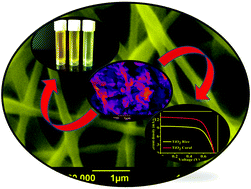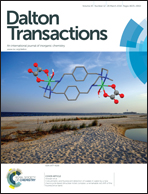A facile approach for high surface area electrospun TiO2 nanostructures for photovoltaic and photocatalytic applications
Abstract
A rice-shaped TiO2–ZnO composite was prepared by electrospinning a mixture comprising the precursors of TiO2 and ZnO in polyvinyl acetate polymer dissolved in N,N-dimethyl acetamide. The electrospun nanofibers upon heat treatment in air resulted in collapse of the continuous fiber morphology and the formation of the rice-shaped TiO2–ZnO composite. The TiO2–ZnO composite was then treated with dilute acetic acid under hydrothermal conditions to etch ZnO from the TiO2–ZnO composite to get coral-shaped anisotropic TiO2. The structural anisotropy of TiO2 produced by the selective etching of ZnO resulted in a high surface area of 148 m2 g−1 for the TiO2. The initial and final materials were characterized by scanning electron microscopy, transmission electron microscopy, Raman and XPS spectroscopies, powder X-ray diffraction and BET surface area measurements. The utility of the anisotropic TiO2 in photovoltaics and photocatalysis was explored. Dye-sensitized solar cells fabricated using the TiO2 showed a conversion efficiency of 6.54% as against 4.8% for a control experiment with the rice-shaped TiO2. The anisotropic TiO2 also showed good photocatalysis in the degradation of methyl orange dye and phenol.


 Please wait while we load your content...
Please wait while we load your content...